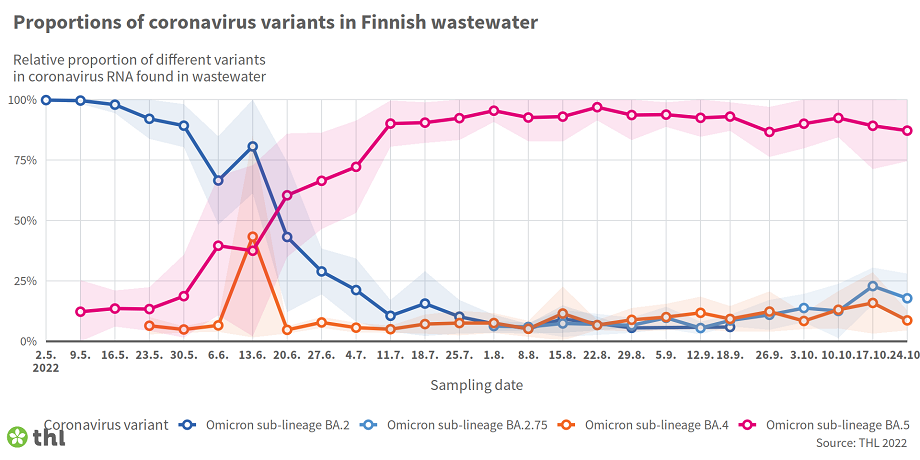Coronavirus wastewater monitoring is reformed – monitoring of other communicable diseases in wastewater is also developed
The method of analysis for the monitoring of the coronavirus in wastewater has been reformed.
The method introduced at the beginning of the coronavirus pandemic determined the amount of coronavirus RNA in wastewater using a DNA-based standard. The now introduced RNA-based standard has been found to be more stable than the previous DNA standard.
The introduction of the RNA standard has reduced the variation between the output points characteristic of the PCR test used in the wastewater analysis. This increases the reliability of the PCR test in monitoring the trend of coronavirus RNA amounts. According to the new standard, the RNA numbers shown in the weekly report are lower than they were previously. However, the change has not been found to affect the sensitivity of the method.
In addition to the analysis method, the structure and accessibility of the weekly report have also been improved.
The results produced with the new standard will be presented retrospectively from 27 June 2022 both nationally and locally in line graphs. The locations to be monitored on a weekly basis and the locations to be monitored on a monthly basis can be found in their own tabs.
The old DNA standard descriptors have been moved to the Monitoring History tab. The Last Two Weeks tab, which was previously in the weekly report, has been deleted, as the corresponding information can be found on other tabs in a new manner. Before the change, the DNA and RNA standards were used in parallel for more than four months, and these results can be found in the Data tab, where all the results of the monitoring the coronavirus in wastewater from 3 August 2020 onward will be shown.
Weekly report on the monitoring of the coronavirus in wastewater (in Finnish)
Omicron BA.5 and its mutated subvariants are the most common subvariants detected in Finnish wastewater
The most recent wastewater samples were collected on 13-14 November 2022. The combined amounts of coronavirus in Finnish wastewater have been steadily increasing for the past two months and are now at a high level.
"The results show that the virus is circulating in different regions and is excreted from infected people into wastewater. The results of the monitoring of coronavirus in wastewater support other indicators of the epidemic,” says Chief Specialist Tarja Pitkänen from THL.
It cannot be determined on the basis of the wastewater results, how many people infected with coronavirus have gotten symptoms of COVID-19 or how severe the symptoms.
The total amount of coronavirus RNA (log10 RNA copies/ 1,000 persons /day) and the number of laboratory-confirmed COVID-19 cases in the treatment plant areas included in the Finnish wastewater sample monitoring between 27 June 2022 and 14 November 2022. Based on the trends of the last five measurements, the RNA numbers are at a high level.
Currently, the Omicron BA.5 variant and its subvariants are the most common virus variants detected in Finnish wastewater. The BA.5 variant’s subvariants are very similar to the main variant, and distinguishing them from each other in water samples is not possible.
There have been no significant changes in the relative proportions of the subvariant since mid-July, when the Omicron BA.5 subvariant became more common than the BA.2 subvariant. Omicron subvariants BA.2, BA.4 and BA.2.75 have also been observed in wastewater, but their relative shares are small.

Total proportions of different SARS-CoV-2 virus variants in Finnish wastewater found in sequenced wastewater samples from monitored wastewater treatment plants between 2 May and 24 October 2022. The lighter-shaded area represents the standard deviation from the results of different treatment plants.
Coronavirus variants in wastewater
The WastPan project is developing the detection of other communicable diseases in wastewater
Microbes that cause infectious diseases other than the coronavirus can also be detected in wastewater.
The WastPan joint project between the Finnish Institute for Health and Welfare, the University of Tampere and the University of Helsinki studies a wide range of wastewater samples from different locations and the microbes and genetic material contained in them to detect pathogens excreted into wastewater as well as antibiotic resistance.
The project produces research-based recommendations and guidelines for wastewater-based monitoring of epidemics. The aim is to detect the signs of communicable diseases in advance in different localities and nationally to control epidemics. The WastPan project is part of the Academy of Finland's programme Pandemics and Other Crises – Response and Preparedness (RESILIENCE) 2021–2023.
The preliminary results of the project will be presented on Thursday 24 November 2022. The event will be organised as a Teams webinar, and it is open to everyone. The webinar will be held in English.
Webinar programme and Teams link to the event
WastPan: Waste water monitoring as a tool for pandemic preparedness
Further information
• Further information on coronavirus variants in wastewater
• Weekly report on wastewater monitoring for coronavirus (in Finnish)
• Coronavirus variants
• Coronavirus wastewater monitoring
Tarja Pitkänen
Chief Specialist
THL
tel. +358 29 524 6315
[email protected]
Anssi Lipponen
Senior Researcher
THL
tel. +358 29 524 7962
[email protected]



